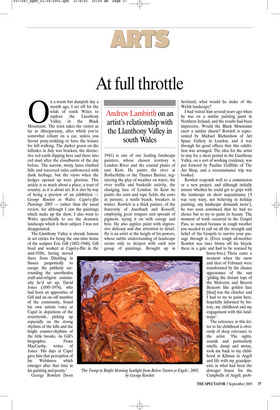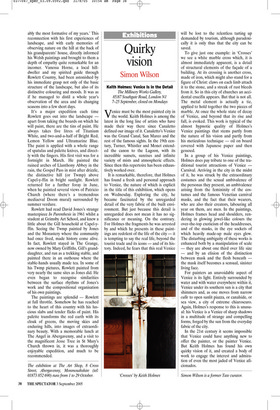At full throttle
Andrew Lambirth on an artist’s relationship with the Llanthony Valley in south Wales
On a warm but dampish day a month ago, I set off for the wilds of south Wales to explore the Llanthony Valley in the Black Mountains. The train takes the visitor as far as Abergavenny, after which you’re somewhat reliant on a car, unless you favour pony-trekking or have the leisure for hill walking. The darker green on the hillsides in July was bracken, the distinctive red earth slipping here and there into red mud after the cloudbursts of the day before. The narrow, twisty lanes climbed hills and traversed vales embowered with dank herbage, but the views when the hedges opened up were glorious. This article is as much about a place, a tract of country, as it is about art. It is also by way of being a preview of an exhibition George Rowlett in Wales: Capel-y-ffin Paintings 2005 — rather than the usual review, for although I saw the paintings which make up the show, I also went to Wales specifically to see the dramatic landscape which is their subject. I was not disappointed.
The Llanthony Valley is already famous in art circles for being the one-time home of the sculptor Eric Gill (1882–1940). Gill lived and worked at Capel-y-ffin in the mid-1920s, having moved there from Ditchling in Sussex purportedly to escape the publicity surrounding the unorthodox craft-and-religion community he’d set up. David Jones (1895–1974), who had been an apprentice of Gill and an on–off member of the community, found his own artistic voice at Capel in depictions of the countryside, picking up especially on the strong rhythms of the hills and the bright counter-rhythms of the little brooks. As Gill’s biographer, Fiona MacCarthy, writes of Jones: ‘His days at Capel gave him that perception of his Welshness which emerges after that time in his painting and poetry.’ George Rowlett (born 1941) is one of our leading landscape painters, whose chosen territory is London River and the coastal plains of east Kent. He paints the river at Rotherhithe or the Thames Barrier, registering the play of weather on water, the river traffic and bankside activity, the changing face of London. In Kent he paints the corn and rape fields, the cows at pasture, a sunlit beach, breakers in winter. Rowlett is a thick painter, of the fraternity of Auerbach and Kossoff, employing great tongues and spreads of pigment, laying it on with energy and brio. He also applies paint with impressive delicacy and due attention to detail. He is an artist at the height of his powers, whose subtle understanding of landscape seems only to deepen with each new group of paintings. Brought up in Scotland, what would he make of the Welsh landscape?
I had visited him several years ago when he was on a similar painting jaunt in Northern Ireland, and the results had been impressive. Would the Black Mountains exert a similar charm? Rowlett is represented by Michael Richardson of Art Space Gallery in London, and it was through his good offices that this exhibition was arranged. The idea for the artist to stay for a short period in the Llanthony Valley, on a sort of working residency, was put forward by Pauline Griffiths of The Art Shop, and a reconnaisance trip was booked.
Rowlett responds well to a commission or a new project, and although initially unsure whether he could get to grips with the landscape on short acquaintance (‘I was very wary, not believing in holiday painting, any landscape demands more’), he was soon convinced that he had no choice but to try to paint its beauty. The moment of truth occurred in the Gospel Pass, so named because in rough weather you needed to call on all the strength and belief of the Gospels to survive your passage through it. (Even tough all-weather Rowlett was later blown off his bicycle there in a gale and had to be rescued by horse-box.) There came a moment when the snow and sleet of February were transformed by the chance appearance of the sun ‘gilding the distant tops of the Malverns and Brecon Beacons like golden lace [that] was the clincher and I had to try to paint here, hopefully informed by history, my childhood and my engagement with this landscape’.
The reference in this letter to his childhood is obviously of deep relevance to the artist. ‘The sights, sounds and particularly smells, damp and mossy, took me back to my childhood at Kilmun in Argyll and life with my grandparents in what had been the dowager house for the Campbells of Argyll, prob ably the most formative of my years.’ This reconnection with his first experiences of landscape, and with early memories of observing nature on the hill at the back of his grandparents’ house, directly informed his Welsh paintings and brought to them a depth of empathy quite remarkable for an incomer. Vanessa Horne, a local hilldweller and my spirited guide through Rowlett Country, had been astonished by his immediate grasp not only of the basic structure of the landscape, but also of its distinctive colouring and moods. It was as if he managed to distil a whole year’s observation of the area and its changing seasons into a few short days.
It’s a major expedition each time Rowlett goes out into the landscape apart from taking the boards on which he will paint, there are the tins of paint. He always takes five litres of Titanium White, and two-and-a-half of Bright Red, Lemon Yellow and Ultramarine Blue. The paint is applied with a whole range of spatulas and palette knives, and directly with the fingers. His first visit was for a fortnight in March. He painted the ruined arches of Llanthony Abbey in the rain, the Gospel Pass in mist after drizzle, the distinctive hill (or Twmp) above Capel-y-ffin in bright sunlight. Rowlett returned for a further foray in June, when he painted several views of Patricio Church (where there’s a tremendous mediaeval Doom mural) surrounded by summer verdure.
Rowlett had read David Jones’s strange masterpiece In Parenthesis in 1961 whilst a student at Grimsby Art School, and knew a little about the Gill household at Capel-yffin. Seeing the Twmp painted by Jones and the Monastery where the community had once lived, made history come alive. In fact, Rowlett stayed in The Grange, now owned by Mary Griffiths, Gill’s granddaughter, and run as a trekking stable, and painted there in an outhouse where the stable-hands usually made tea. In some of his Twmp pictures, Rowlett painted from very nearly the same sites as Jones did. He even began to recognise similarities between the surface rhythms of Jones’s work and the compositional organisation of his own paintings.
The paintings are splendid — Rowlett at full throttle. Somehow he has reached to the heart of this country with his luscious slabs and tender flicks of paint. His palette transforms the red earth with its cloak of greens, the moving skies and enduring hills, into images of extraordinary beauty. With a memorable lunch at The Angel in Abergavenny, and a visit to the magnificent Jesse Tree in St Mary’s Church thrown in, it was a thoroughly enjoyable expedition, and much to be recommended.
The exhibition at The Art Shop, 8 Cross Street, Abergavenny, Monmouthshire (tel: 01873 852 690) runs from 1 to 29 October.










































 Previous page
Previous page